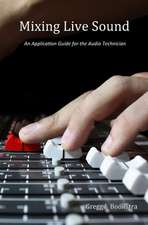Underwater Acoustic Modelling and Simulation
Autor P.C. Etteren Limba Engleză Hardback – 13 feb 2003
Previous editions of the book have provided invaluable guidance to sonar technologists, acoustical oceanographers and applied mathematicians in the selection and application of underwater acoustic models. Now that simulation is fast becoming an accurate, efficient and economical alternative to field-testing and at-sea training, this new edition will also provide useful guidance to systems engineers and operations analysts interested in simulating sonar performance.
Guidelines for selecting and using available propagation, noise and reverberation models are highlighted. Specific examples of each type of model are discussed to illustrate model formulations, assumptions and algorithm efficiency. Instructive case studies demonstrate applications in sonar simulation.
Preț: 1968.13 lei
Preț vechi: 2744.64 lei
-28% Nou
Puncte Express: 2952
Preț estimativ în valută:
376.65€ • 391.78$ • 310.95£
376.65€ • 391.78$ • 310.95£
Carte tipărită la comandă
Livrare economică 14-28 aprilie
Preluare comenzi: 021 569.72.76
Specificații
ISBN-13: 9780419262206
ISBN-10: 0419262202
Pagini: 446
Ilustrații: 24 tables and 145 line drawings
Dimensiuni: 156 x 234 x 29 mm
Greutate: 0.84 kg
Ediția:3Revizuită
Editura: CRC Press
Colecția CRC Press
ISBN-10: 0419262202
Pagini: 446
Ilustrații: 24 tables and 145 line drawings
Dimensiuni: 156 x 234 x 29 mm
Greutate: 0.84 kg
Ediția:3Revizuită
Editura: CRC Press
Colecția CRC Press
Public țintă
Postgraduate and ProfessionalCuprins
Introduction. Acoustical Oceanography. Propagation I. Observations and Physical Models. Propagation II. Mathematical Models (Part One). Propagation II. Mathematical Models (Part Two). Noise I. Observations and Physical Models. Noise II. Mathematical Models. Reverberation I. Observations and Physical Models. Reverberation II. Observations and Physical Models. Sonar Performance Models. Model Evaluation. Simulation.
Notă biografică
Paul C. Etter has worked in the fields of ocean-atmosphere physics and environmental acoustics for the past thirty years, supporting federal and state agencies, academia and private industry. He received his BS degree in Physics and his MS degree in Oceanography at Texas A&M University. Mr. Etter served on active duty in the US Navy as an Anti-Submarine Warfare (ASW) Officer aboard frigates, where he was responsible for the tactical operation of the ships' sonar systems. He is the author or co-author of more than 170 technical reports and professional papers addressing environmental measurement technology, underwater acoustics and physical oceanography. Mr. Etter has written two editions of the book entitled Underwater Acoustic Modeling and has contributed chapters to three other books dealing with physics of the oceans.
Recenzii
'Underwater Acoustic Modeling and Simulation meets the highest standards of professional writing and scholarship. The book is thorough yet very readable. It belongs in libraries that serve a naval, geophysical or oceanographic clientele or any college or university serving the graduate applied physics or maths student.' - E-Streams
'This book is unique in combining theoretical, empirical, and computational models for underwater propagation, noise, and sonar operation. It will be a valuable resource to anyone engaged in underwater acoustic modeling and simulation, and I am pleased to recommend it.' - Bulletin of the American Meteorological Society
'... Underwater Acoustic Modeling does an excellent job of introducing propagation, noise, and reverberation in the underwater environment. The author's style makes the book very readable, without compromising the breadth of coverage.' - The Industrial Physicist
'This book is unique in combining theoretical, empirical, and computational models for underwater propagation, noise, and sonar operation. It will be a valuable resource to anyone engaged in underwater acoustic modeling and simulation, and I am pleased to recommend it.' - Bulletin of the American Meteorological Society
'... Underwater Acoustic Modeling does an excellent job of introducing propagation, noise, and reverberation in the underwater environment. The author's style makes the book very readable, without compromising the breadth of coverage.' - The Industrial Physicist
Descriere
Underwater Acoustic Modeling and Simulation examines the translation of our physical understanding of sound in the sea into mathematical models that can simulate acoustic propagation, noise and reverberation in the ocean. These models are used
























